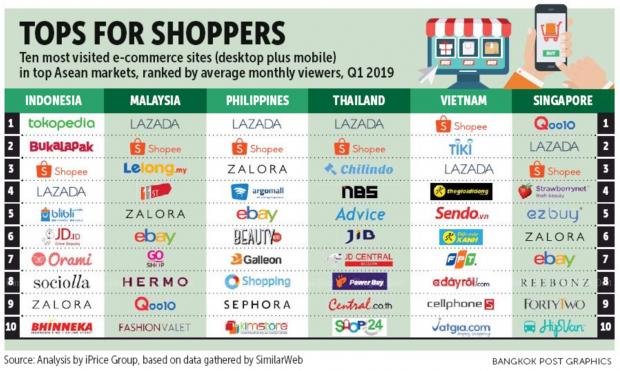Asean’s mobile e-commerce leaders
Mobile apps are playing a vital role in the development of e-commerce. According to a report by Google and Temasek, there are more than 350 million internet users in the six largest markets in Southeast Asia (Indonesia, Malaysia, the Philippines, Singapore, Thailand and Vietnam).
More importantly, more than 90% of Southeast Asians connect to the internet primarily through mobile devices. This figure is expected to rise as smartphones become more accessible and networks become faster. Overall, Google and Temasek expect the e-commerce market in the region to be worth UScopy02 billion by 2025.
As e-commerce firms race to realise their mobile-first potential, iPrice Group sought to identify which mobile shopping apps were most actively used in the first quarter of 2019. It partnered with App Annie Intelligence, an app market insights company, to identify top mobile players based on average monthly active users (MAU).
Combined desktop and mobile rankings (see table), based on data gathered by SimilarWeb, are also highly relevant in Southeast Asia. The 2017 “State of E- commerce” study by iPrice noted that while consumers used mobile apps to search for information, they were more likely to make their actual purchases via the desktop.
Three mobile leaders: Lazada’s mobile shopping app topped the table for MAU in the Philippines, Malaysia, Thailand and Singapore. The Alibaba-backed site also ranked second in Vietnam and fourth in Indonesia.
In the past year, Lazada has concentrated heavily on developing its application to serve consumers’ constantly evolving habits. Among the many new features are in-app live streaming and an Image Search feature that Lazada says is used by 500,000 customers daily to find some 20 million products, plus the Shake It in-app game.
Lazada’s closest mobile competitor in the region is Shopee, ranking highest in Vietnam, second in Indonesia, the Philippines, Malaysia and Thailand, and third in Singapore.
Also aware of the importance of mobile apps in the region, Shopee has prioritised a “hyper-localised” user experience by having a different app for each country. This has been an effective strategy, helping Shopee rise quickly since its founding in 2015.
Another prominent competitor is Tokopedia, which leads the market in Indonesia, Asean’s biggest economy and largest country by population. Last year, Tokopedia was the third most visited e-commerce platform in Southeast Asia even though it was available only in a single country, with an average of 125 million visitors a month.
Chinese and American apps: Chinese and US e-commerce mobile apps are also actively used in the region, among them AliExpress, Amazon, eBay, Taobao and Alibaba.com.
Chinese apps such as Taobao perform well in countries where there are more consumers proficient in the Chinese language. This was evident in Singapore and Malaysia, where the app ranked fourth and third respectively. Taobao is available primarily in the Chinese language and provides delivery services to Southeast Asia as well.
AliExpress, on the other hand, is optimised for consumers who do not speak or read Chinese and is actively used in Thailand (third place), the Philippines (fifth), Malaysia (fifth), Vietnam (sixth) and Indonesia (eighth place).
Amazon.com is popular in the Philippines, ranking fourth overall, ahead of Chinese rivals AliExpress (fifth) and Alibaba.com (ninth).
In Southeast Asia, Amazon officially launched its services in Singapore in 2017 with Amazon Prime Now and currently ranks ninth in the city-state. Amazon also ranks fifth in Thailand and seventh in Vietnam.
Local champions: Tokopedia was the only mobile e-commerce app in Asean that topped the table in its home country. The Indonesian company recently received copy billion from existing investors, making it the most valuable startup in the country.
Tokopedia founder William Tanuwijaya has capitalised on the country’s rapid adoption of smartphones and increasing comfort with shopping online. Tokopedia leads in both mobile and desktop visits in its home market.
Other e-commerce apps that performed well in their respective home countries were Qoo10 (second in Singapore), Tiki (third in Vietnam) and 11street (fourth in Malaysia).
Among the key findings from the first-quarter 2019 survey:
Shopee was the most visited e-commerce platform in Southeast Asia overall (mobile plus desktop) in the first quarter with a total average of 184.8 million visitors a month.
Lazada saw a 12% decline in average monthly visits when compared with the previous quarter, to 179.7 million.
Tokopedia (Indonesia), Bukalapak (Indonesia) and Tiki (Vietnam) were the third, fourth and fifth most visited e-commerce platforms in Southeast Asia, though each was available only in a single market.
Despite a 12% dip in total average visits, Lazada remains the most visited e-commerce platform in the Philippines, Thailand, Malaysia and Singapore.
Apart from Indonesia and Vietnam, other locally based e-commerce platforms that performed well were Lelong (third in Malaysia), Argomall (fourth in Philippines), Qoo10 (first in Singapore) and Chilindo (third in Thailand).
Source: https://www.bangkokpost.com/tech/world-updates/1682480/aseans-mobile-e-commerce-leaders


 English
English




